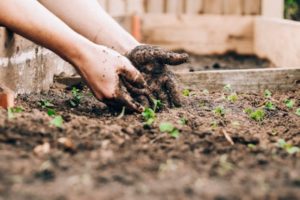
Big gardens with a variety of crops from corn and green beans to cauliflower was the norm for me growing up on a farm. But, over the years, my personal gardening experiences have been limited to tomatoes, herbs and the occasional eggplant or zucchini. However, growing leafy greens and kale (thanks to my husband) became a reality last spring with more time at home. The leaf lettuce produced during its usual limited time span but the resilience of our kale growing in a large ceramic container became our “pandemic sourdough” and the centerpiece of countless meals and conversations! (See my blog about the experience)

Follow these five basic guidelines for starting your “green thumb” experience:
1. Match container size with vegetable size and growth. Containers can be of various size, form or shape and made of clay, redwood or plastic.
a. Use a 6 to 8-inch container for vegetables like beets, broccoli, cucumbers, kale, lettuce, onions, spinach, Swiss chard, radishes or turnips.
b. Use at least a 10-inch deep container for green beans, cabbage, carrots, collard and peas. For cabbage and broccoli, use a single pot if the container is not large enough for vegetables to be planted at least 15 inches apart.
c. Use window boxes for herbs and early season leafy greens like leaf lettuce, spinach and curly kale.
d. Increase the size of the container to a 4–5-gallon bucket for the following vegetables: eggplant, tomato, pepper, yellow squash and zucchini. You may be able to secure some food-grade buckets from your local bakery, restaurants or other food service establishments as these contain no chemical residues.
e. Use wire caging to promote vertical growth and provide a little protection from the “norms of nature” such as squirrels and deers.
2. Select vegetables for your available space. Cool, shaded areas work well for leafy greens while heat-loving plants like eggplant enjoy full sun. These types of vegetables do well in locations where sun reflections from buildings or patio surfaces add to the heat.
3. Use commercially prepared soil mix in the containers. This will allow for good water drainage.
4. Water and “feed” your plants. Plants are like us; they need proper hydration and nourishment. Follow the appropriate watering guidelines and recommended fertilizer (synthetic or organic) for your selected plants.
5. Be patient with pests. Pests will appear but with small plantings, handpicking bugs or spraying water may be the first option before using a pesticide.
With the proper care and attention, a backyard or balcony bounty can be in your future.
Sources:
1. “Growing vegetables in containers,” Messenger-Inquirer, by Annette Meyer Heisdorffer, March 15, 2020.
2. Daviess County Cooperative Extension: Horticulture
3. John Edge, Home Gardener
